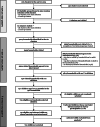Immunisation coverage and factors associated with incomplete immunisation in children under two during the COVID-19 pandemic in Sierra Leone
- PMID: 38200476
- PMCID: PMC10777622
- DOI: 10.1186/s12889-023-17534-2
Immunisation coverage and factors associated with incomplete immunisation in children under two during the COVID-19 pandemic in Sierra Leone
Abstract
Background: Routine childhood immunisation is one of the most important life-saving public health interventions. However, many children still have inadequate access to these vaccines and millions remain (partially) unvaccinated globally. As the COVID-19 pandemic disrupted health systems worldwide, its effects on immunisation have become apparent. This study aimed to estimate routine immunisation coverage among children under two in Sierra Leone and to identify factors associated with incomplete immunisation during the COVID-19 pandemic.
Methods: A cross-sectional household survey was conducted in three districts in Sierra Leone: Bombali, Tonkolili and Port Loko. A three-stage cluster sampling method was followed to enrol children aged 10-23 months. Information regarding immunisation status was based on vaccination cards or caretaker's recall. Using WHO's definition, a fully immunised child received one BCG dose, three oral polio vaccine doses, three pentavalent vaccine doses and one measles-containing vaccine dose. Following the national schedule, full immunisation status can be achieved at 9 months of age. Data were weighted to reflect the survey's sampling design. Associations between incomplete immunisation and sociodemographic characteristics were assessed through multivariable logistic regression.
Results: A total of 720 children were enrolled between November and December 2021. Full vaccination coverage was estimated at 65.8% (95% CI 60.3%-71.0%). Coverage estimates were highest for vaccines administered at birth and decreased with doses administered subsequently. Adjusting for age, the lowest estimated coverage was 40.7% (95% CI 34.5%-47.2%) for the second dose of the measles-containing vaccine. Factors found to be associated with incomplete immunisation status were: living in Port Loko district (aOR = 3.47, 95% CI = 2.00-6.06; p-value < 0.001), the interviewed caretaker being Muslim (aOR = 1.94, 95% CI = 1.25-3.02; p-value = 0.015) and the interviewed caretaker being male (aOR = 1.93, 95% CI = 1.03-3.59, p-value = 0.039).
Conclusion: Though full immunisation coverage at district level improved compared with pre-pandemic district estimates from 2019, around one in three surveyed children had missed at least one basic routine vaccination and over half of eligible children had not received the recommended two doses of a measles-containing vaccine. These findings highlight the need to strengthen health systems to improve vaccination uptake in Sierra Leone, and to further explore barriers that may jeopardise equitable access to these life-saving interventions.
Keywords: Childhood immunisation; Household survey; Routine immunisation coverage; Sierra Leone.
© 2023. The Author(s).
Conflict of interest statement
The authors declare no competing interests.
Figures



References
-
- World Health Organization. Immunization agenda 2030: a global strategy to leave no one behind. 2020. https://www.who.int/publications/m/item/immunization-agenda-2030-a-globa.... Accessed 18 May 2022.
-
- World Health Organization. Vaccination schedule for Sierra Leone. https://immunizationdata.who.int/pages/schedule-by-country/sle.html?DISEASECODE=&TARGETPOP_GENERAL=. Accessed 18 May 2022.
Publication types
MeSH terms
Substances
Grants and funding
LinkOut - more resources
Full Text Sources
Medical
Research Materials

